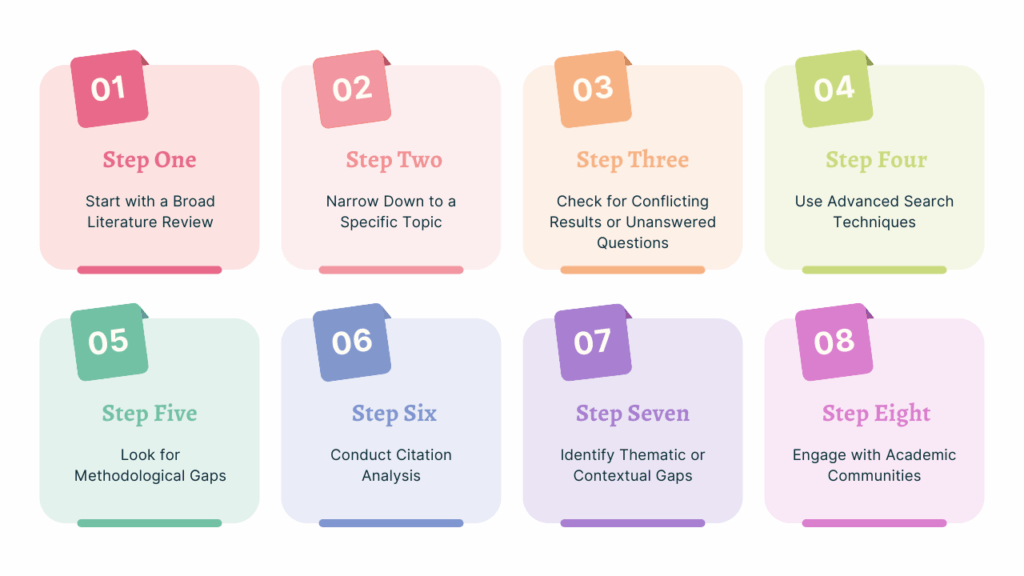How to Identify a Research Gap for Your Thesis, Dissertation, or Journal Paper?
Kenfra Research - Bavithra2025-09-26T17:10:12+05:30Finding a research gap is one of the most important steps in your research journey. Whether you’re starting your PhD, building your academic career, or planning to publish a paper, finding the right gap can make your study more original and meaningful. But how do you know what has not been studied yet in your field? That’s where the real question begins — how to identify a research gap.
In this blog, we’ll explain simple and practical ways to help you spot a real gap in the existing research. By the end, you’ll have a clear idea of how to identify a research gap and shape your research in the right direction.
What is a Research Gap?
A research gap refers to an unexplored or under-explored area in existing literature. It can be a missing link, an unanswered question, or a contradiction in findings within your domain. Identifying a gap means finding an opportunity to contribute something new, relevant, and meaningful to your field.
Why is Identifying a Research Gap Important?
- Ensures originality of your research
- Increases chances of publication in reputed journals
- Strengthens your research proposal or PhD thesis
- Solves real-world problems that haven’t been addressed
- Attracts interest from supervisors, funding bodies, and institutions
Without a clear gap, your work may appear repetitive or irrelevant—even if executed well.

Step-by-Step Guide to Identify a Research Gap in Your Domain
1. Start with a Broad Literature Review
Begin by reading recent journal articles, conference papers, PhD thesis, and systematic reviews in your field. Focus on top journals indexed in Scopus, Web of Science, or UGC-CARE. The goal is to understand what has already been done.
Pro Tip: Create a research matrix to organize findings, methodologies, and conclusions of different authors. This makes it easier to spot missing links.
2. Narrow Down to a Specific Topic
Once you’re familiar with the broader field, zoom into a niche area that aligns with your interests and academic goals for your PhD research. For example, in Electrical Engineering, instead of focusing on “Renewable Energy”, narrow it to “Optimization of Solar Inverter Efficiency in Smart Grids”.
A narrow focus allows you to go deep and examine micro-level gaps that are often overlooked.
3. Check for Conflicting Results or Unanswered Questions
One of the strongest indicators of a research gap is conflicting findings in previous studies. For instance, if two studies show contradictory outcomes using the same methodology, there’s space for a fresh approach.
Also, pay attention to the “Limitations” and “Future Work” sections of papers—they often directly mention what’s missing or what needs to be explored further.
4. Use Advanced Search Techniques
Utilize databases like Google Scholar, IEEE Xplore, PubMed, Springer, or ScienceDirect with Boolean operators (AND, OR, NOT) to refine your search.
For example:
- “machine learning in healthcare” AND “challenges”
- “consumer behavior” NOT “digital marketing”
These techniques help you avoid general content and focus only on areas where research is lacking.
5. Look for Methodological Gaps
Sometimes, the topic has been researched, but the approach or research methodology is outdated or not suitable. This is called a methodological gap.
Ask:
- Was the sample size too small?
- Was a qualitative method used when a quantitative one was better suited?
- Is there room to apply new technologies or models?
Offering an improved methodology can turn even a saturated topic into a fresh research opportunity.

6. Conduct Citation Analysis
Highly cited papers are usually foundational, while low-citation or recent papers might indicate unexplored or niche areas. Use tools like Publish or Perish, Scopus, or Google Scholar metrics to track citations.
This helps you identify which studies are gaining traction and which ones are still in the early stages perfect for carving your own space.
7. Identify Thematic or Contextual Gaps
A topic may be well-researched in the global context but under-studied in your local context or a specific demographic.
Example:
“Impact of AI in education” might be widely studied in Europe but not in rural Indian schools.
This kind of contextual gap allows you to localize your study while staying relevant globally.
8. Engage with Academic Communities
Participate in seminars, webinars, research forums, and PhD networks. Sometimes, discussing with experts and peers can reveal an academic research gap you might have missed. These discussions can also give you insights into the current research methodology trends in your field.
Also, talking to your supervisor or mentor can help validate whether the gap you’ve found is worth exploring.
About Kenfra Research
At Kenfra Research, we empower scholars, PhD aspirants, and academic professionals with complete research support—from topic selection to thesis writing, journal publication, plagiarism checking, and formatting as per university guidelines. With years of experience and a dedicated team of experts across disciplines, we help you simplify your research journey and achieve academic excellence.
Whether you’re struggling to identify a research gap or need end-to-end guidance, Kenfra is your trusted partner for success.
Make Your Research Stand Out
Finding the right research gap takes time, curiosity, and critical thinking. Don’t rush the process. A well-identified gap not only makes your research unique but also increases your confidence as a scholar. Remember, the best research is not the one that covers everything—it’s the one that covers one specific thing really well.
If you’re still unsure about identifying a research gap or need end-to-end PhD support, Kenfra Research is here to guide you. From topic selection to thesis writing and journal publication, we help you succeed in your academic journey.








Leave a Reply